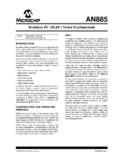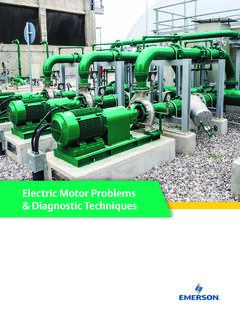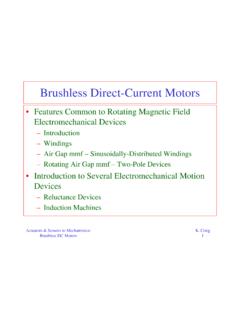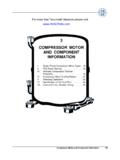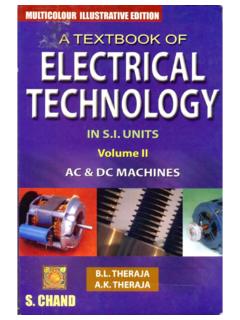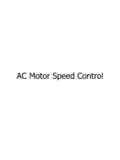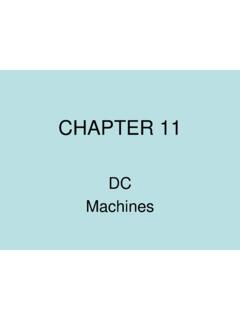Transcription of IEC STANDARDS FOR VARIABLE SPEED DRIVES AND MOTOR …
1 IEC STANDARDS FOR VARIABLE SPEED DRIVES AND MOTOR winding INSULATION Copyright Material PCIC Europe Paper No. PCIC Middle-East 2014-08 Greg C. Stone Blake A. Lloyd Qualitrol-Iris Power Qualitrol-Iris Power 3110 American Drive, Mississauga, Ontario 3110 American Drive, Mississauga, Ontario Canada L4V 1T2 Canada L4V 1T2 Abstract - Modern inverter-fed motors often see short risetime, high magnitude voltage surges that may lead to partial discharge. Fast risetime transients from the drive, as well as possible voltage doubling caused by transmission line impedance mismatches, can result in partial discharges (PD) in the MOTOR stator winding even in low voltage motors.
2 Testing for such conditions is described in IEC TS 60034-18-41 [1] which indicates that the manufacturer must prove the MOTOR will not have PD for the expected life of the MOTOR and sets PD inception voltage limits, based on severity of the surge environment. Medium- and high-voltage motors may also suffer from this type of inverter specifically the stress relief coatings may age prematurely. IEC 60034-18-42 [2] provides tests that MOTOR manufacturers can perform to ensure that such premature failure will not occur. This paper describes these two STANDARDS and comments on their effectiveness.
3 Index Terms VARIABLE SPEED drive, MOTOR qualification, partial discharge. I. INTRODUCTION NEMA MG-1 Part 31 was an early standard concerning VARIABLE SPEED drive (VSD) motors and requires low-voltage (<600 V) inverter-duty MOTOR windings to survive a voltage impulse test with a magnitude times the rated phase-to-phase voltage. More recently, there has been some recognition that the short-time impulse test will not always insure a satisfactory winding insulation life, at least for low-voltage VSD motors [3, 4, 5].
4 Part 31 also requires medium-voltage (>600 V) motors to survive an impulse test at times the rated phase-to-phase voltage. Form-wound coils are often tested according to [6], where the requirement of the test is an applied impulse with a crest value equal to times the peak line-to-ground voltage. Another IEC document [7] discusses MOTOR insulation electrical stresses in detail. It provides a curve of expected impulse voltage at MOTOR terminals and suggests applying motors within that limit. However, in all these cases, tests deal more with short term withstand rather than assuring satisfactory insulation life.
5 To fill this gap, IEC Technical Committee (TC) 2 on Rotating Machines initiated a working group to develop a technical specification defining insulation tests to assure design suitability for operation with a modern (fast switching 50-2000nS rise-time) VSD inverter. These STANDARDS define a collection of tests for both low- and medium-voltage motors (up to kV). IEC 60034-18-41 covers Type I insulation systems (typically random-wound stators), while the IEC 60034-18-42 document covers Type II insulation (typically form-wound coils). II.
6 STRESSES ON VSD MOTOR INSULATION Reliability of the stator insulation system is the principal concern of both VSD MOTOR manufacturers and users. The insulation systems in question are the turn-to-turn, phase-to-ground, and phase-to-phase insulation. As these insulation systems are different for random-wound and form-wound stators, there are separate STANDARDS for each. A. Random-Wound MOTOR Stators Fig. 1 shows the components of the winding insulation system in a random-wound stator, which usually apply to motors rated <1,000 V (Type I machines).
7 Pulse Width Modulation (PWM) inverters using insulated gate bipolar transistors (IGBTs) or similar switching devices create relatively high magnitude, short-rise-time voltage impulses that travel to the MOTOR terminals. Many factors such as cable length, cable grounding, and the relative surge impedance of the cable and the stator winding affect the magnitude of the impulse voltages impinging on the MOTOR winding . In some circumstances, these surges can be as much as three or four times the rated, rms phase-to-ground voltage, with a risetime as short as 50 ns [5, 8].
8 These fast risetime surges result in a non-uniform distribution of the impulse voltage across the winding components [7 to 10] with the turns in the first coil seeing much higher stress than the rest of the winding . The severity of the VSD impulses increases as either the magnitude increases or the risetime decreases. In random-wound stators, there are often small air gaps between turns, between turn and ground, and between phases. The high voltage impulses, although brief, can cause the electrical stress in the normally occurring small air gaps between turns, between turns and ground, and between phases.
9 If this stress exceeds the dielectric breakdown strength of air (about 3 kV/mm for uniform fields) a partial discharge (PD) - or small electric spark will occur. Over time, repetitive PD will erode the insulation film on the magnet wire, or even the ground and phase insulation barriers eventually failing the MOTOR . Machine designers recognizing this issue have developed many ways to prevent the occurrence of PD in random-wound stator windings. These include increasing the insulation thickness of the magnet wire and/or the ground and phase insulation; improved varnish impregnation methods such as trickle impregnation, vacuum pressure impregnation (VPI); and other processes to reduce the number and size of voids.
10 The intent of the IEC standard is to specify test methods that assure a given stator insulation design can prevent formation of PD in new windings and continue to suppress PD throughout the life of the MOTOR (Type I insulation). Fig. 1 Magnet wire at high stress in air voids B. Form-Wound MOTOR Stators Unlike random-wound systems, in form-wound coils the turns always occupy a defined location within the coil. These machines generally operate at higher rated voltages (>690 V) and, because they may experience PD within their lifetime, are defined by IEC 60034-18-42 as Type II.


